Recycling in NUS: Waste Management Infrastructure and Initiatives
VerifiedAdded on 2023/06/12
|16
|3899
|419
AI Summary
This report discusses the waste management infrastructure of Singapore and the recycling initiatives taken by National University of Singapore (NUS). It covers the measures for successful recycling of paper, metal, plastics, glass, and electronic waste. The report also includes information on the associated costs of recycling and the development of an integrated waste management facility (IWMF).
Contribute Materials
Your contribution can guide someone’s learning journey. Share your
documents today.
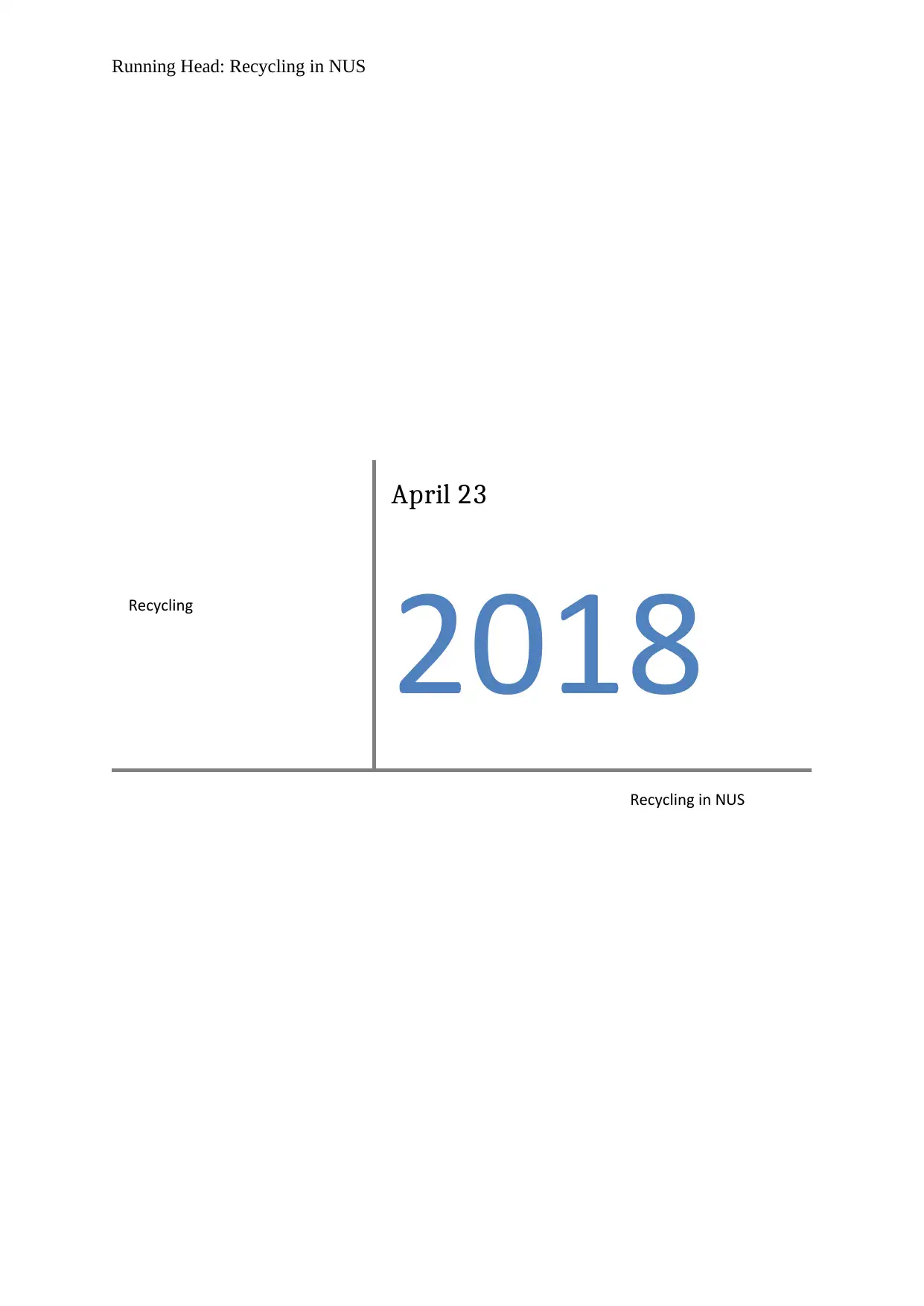
Running Head: Recycling in NUS
Recycling
April 23
2018
Recycling in NUS
Recycling
April 23
2018
Recycling in NUS
Secure Best Marks with AI Grader
Need help grading? Try our AI Grader for instant feedback on your assignments.
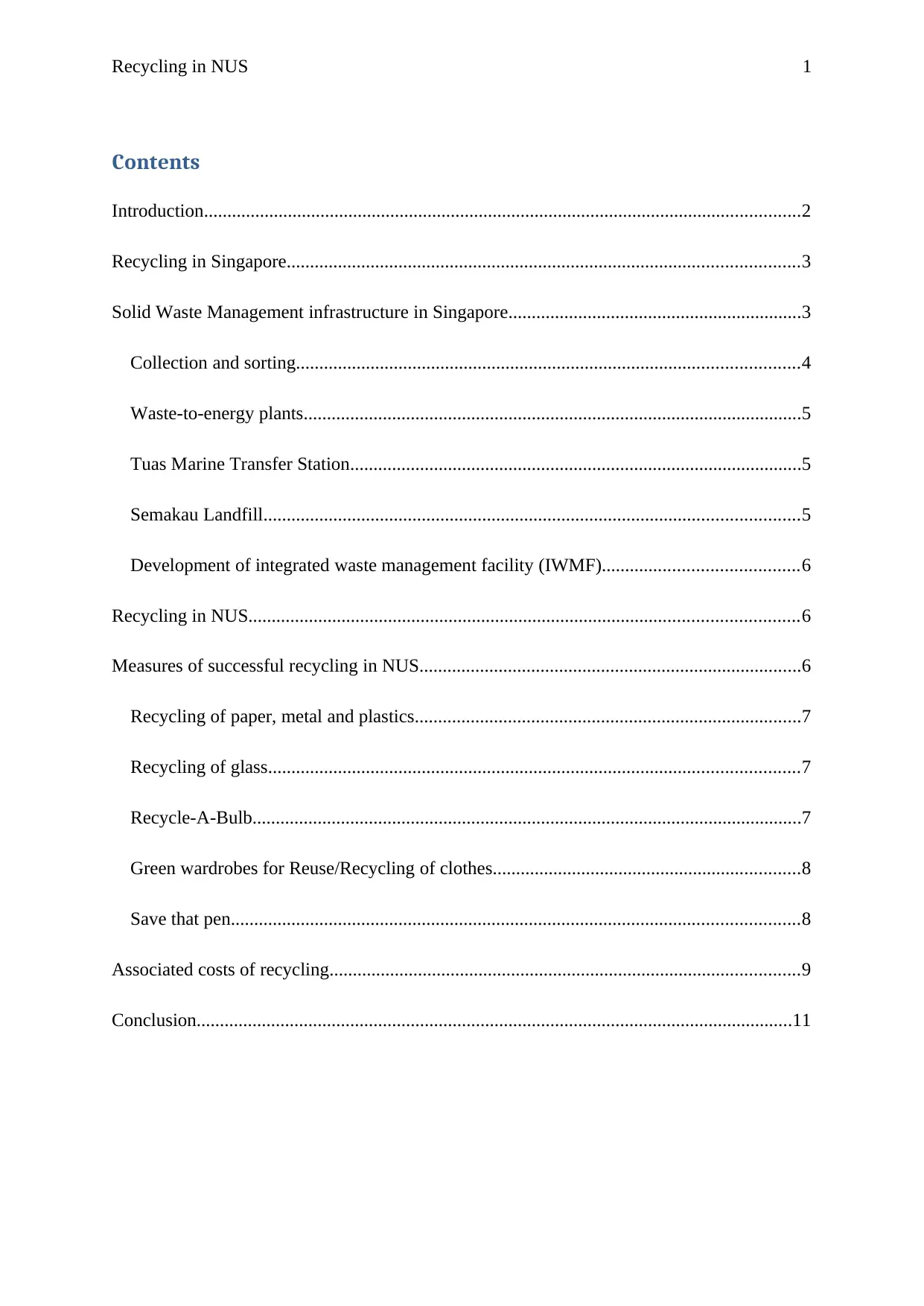
Recycling in NUS 1
Contents
Introduction................................................................................................................................2
Recycling in Singapore..............................................................................................................3
Solid Waste Management infrastructure in Singapore...............................................................3
Collection and sorting............................................................................................................4
Waste-to-energy plants...........................................................................................................5
Tuas Marine Transfer Station.................................................................................................5
Semakau Landfill...................................................................................................................5
Development of integrated waste management facility (IWMF)..........................................6
Recycling in NUS......................................................................................................................6
Measures of successful recycling in NUS..................................................................................6
Recycling of paper, metal and plastics...................................................................................7
Recycling of glass..................................................................................................................7
Recycle-A-Bulb......................................................................................................................7
Green wardrobes for Reuse/Recycling of clothes..................................................................8
Save that pen..........................................................................................................................8
Associated costs of recycling.....................................................................................................9
Conclusion................................................................................................................................11
Contents
Introduction................................................................................................................................2
Recycling in Singapore..............................................................................................................3
Solid Waste Management infrastructure in Singapore...............................................................3
Collection and sorting............................................................................................................4
Waste-to-energy plants...........................................................................................................5
Tuas Marine Transfer Station.................................................................................................5
Semakau Landfill...................................................................................................................5
Development of integrated waste management facility (IWMF)..........................................6
Recycling in NUS......................................................................................................................6
Measures of successful recycling in NUS..................................................................................6
Recycling of paper, metal and plastics...................................................................................7
Recycling of glass..................................................................................................................7
Recycle-A-Bulb......................................................................................................................7
Green wardrobes for Reuse/Recycling of clothes..................................................................8
Save that pen..........................................................................................................................8
Associated costs of recycling.....................................................................................................9
Conclusion................................................................................................................................11
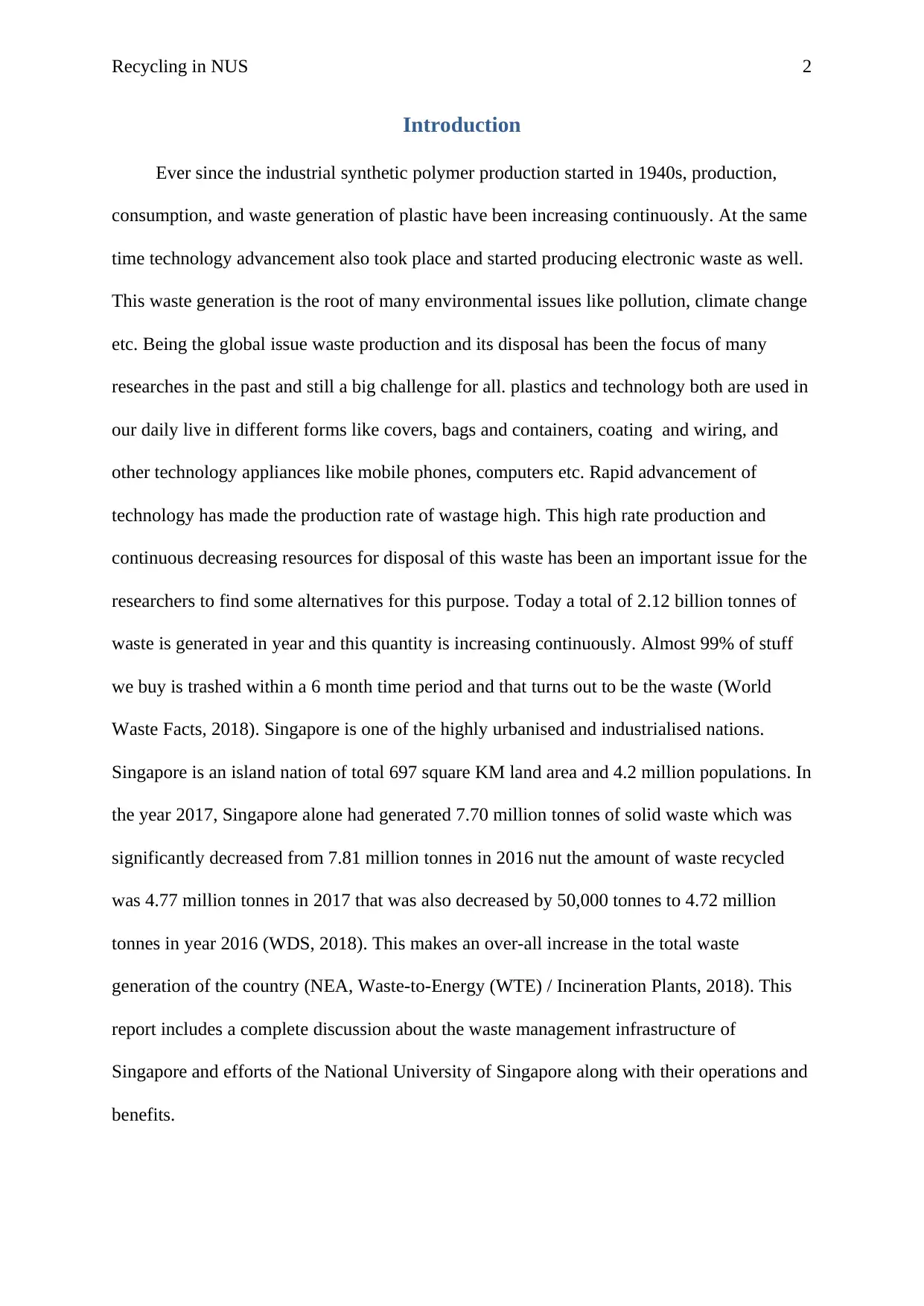
Recycling in NUS 2
Introduction
Ever since the industrial synthetic polymer production started in 1940s, production,
consumption, and waste generation of plastic have been increasing continuously. At the same
time technology advancement also took place and started producing electronic waste as well.
This waste generation is the root of many environmental issues like pollution, climate change
etc. Being the global issue waste production and its disposal has been the focus of many
researches in the past and still a big challenge for all. plastics and technology both are used in
our daily live in different forms like covers, bags and containers, coating and wiring, and
other technology appliances like mobile phones, computers etc. Rapid advancement of
technology has made the production rate of wastage high. This high rate production and
continuous decreasing resources for disposal of this waste has been an important issue for the
researchers to find some alternatives for this purpose. Today a total of 2.12 billion tonnes of
waste is generated in year and this quantity is increasing continuously. Almost 99% of stuff
we buy is trashed within a 6 month time period and that turns out to be the waste (World
Waste Facts, 2018). Singapore is one of the highly urbanised and industrialised nations.
Singapore is an island nation of total 697 square KM land area and 4.2 million populations. In
the year 2017, Singapore alone had generated 7.70 million tonnes of solid waste which was
significantly decreased from 7.81 million tonnes in 2016 nut the amount of waste recycled
was 4.77 million tonnes in 2017 that was also decreased by 50,000 tonnes to 4.72 million
tonnes in year 2016 (WDS, 2018). This makes an over-all increase in the total waste
generation of the country (NEA, Waste-to-Energy (WTE) / Incineration Plants, 2018). This
report includes a complete discussion about the waste management infrastructure of
Singapore and efforts of the National University of Singapore along with their operations and
benefits.
Introduction
Ever since the industrial synthetic polymer production started in 1940s, production,
consumption, and waste generation of plastic have been increasing continuously. At the same
time technology advancement also took place and started producing electronic waste as well.
This waste generation is the root of many environmental issues like pollution, climate change
etc. Being the global issue waste production and its disposal has been the focus of many
researches in the past and still a big challenge for all. plastics and technology both are used in
our daily live in different forms like covers, bags and containers, coating and wiring, and
other technology appliances like mobile phones, computers etc. Rapid advancement of
technology has made the production rate of wastage high. This high rate production and
continuous decreasing resources for disposal of this waste has been an important issue for the
researchers to find some alternatives for this purpose. Today a total of 2.12 billion tonnes of
waste is generated in year and this quantity is increasing continuously. Almost 99% of stuff
we buy is trashed within a 6 month time period and that turns out to be the waste (World
Waste Facts, 2018). Singapore is one of the highly urbanised and industrialised nations.
Singapore is an island nation of total 697 square KM land area and 4.2 million populations. In
the year 2017, Singapore alone had generated 7.70 million tonnes of solid waste which was
significantly decreased from 7.81 million tonnes in 2016 nut the amount of waste recycled
was 4.77 million tonnes in 2017 that was also decreased by 50,000 tonnes to 4.72 million
tonnes in year 2016 (WDS, 2018). This makes an over-all increase in the total waste
generation of the country (NEA, Waste-to-Energy (WTE) / Incineration Plants, 2018). This
report includes a complete discussion about the waste management infrastructure of
Singapore and efforts of the National University of Singapore along with their operations and
benefits.
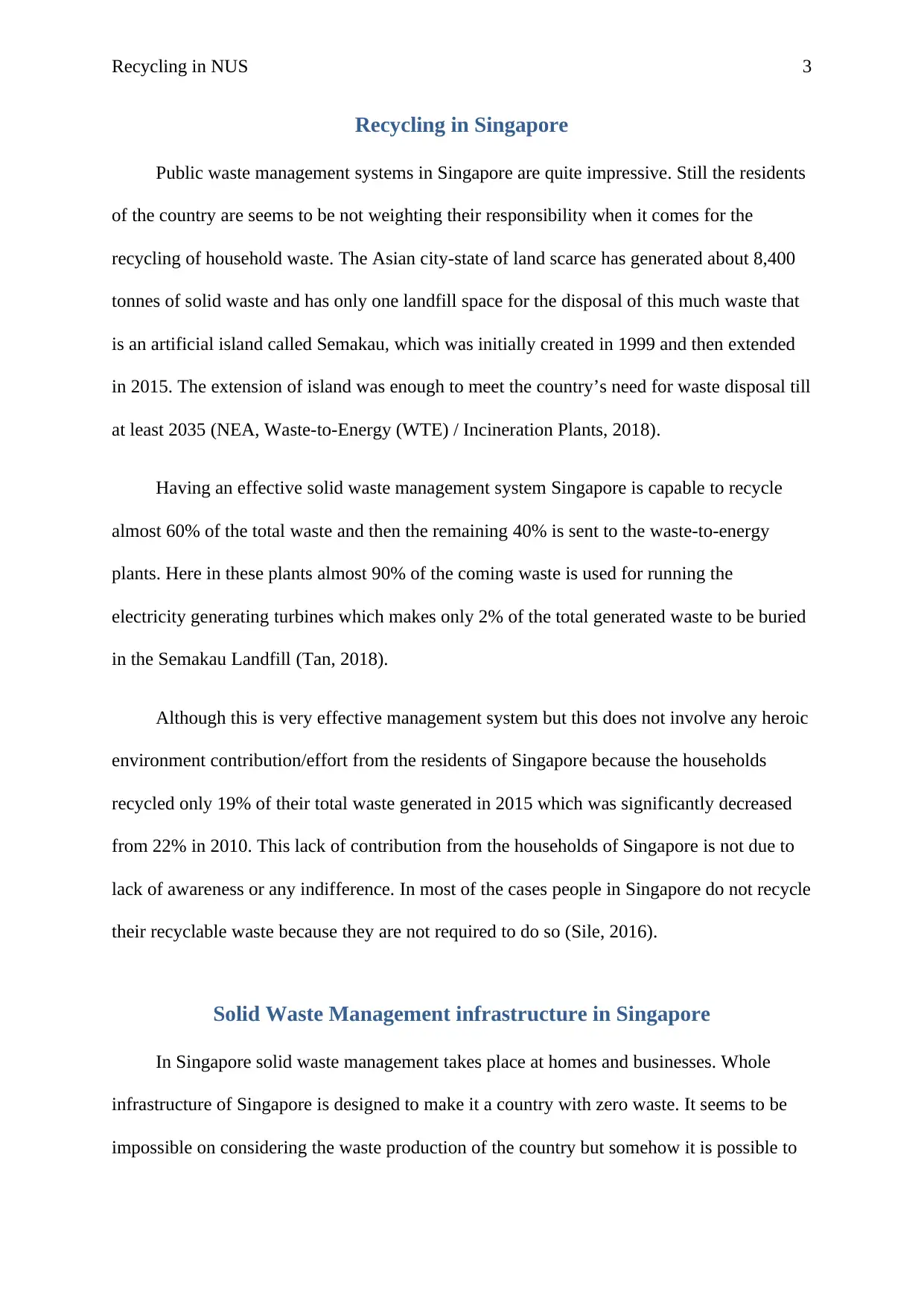
Recycling in NUS 3
Recycling in Singapore
Public waste management systems in Singapore are quite impressive. Still the residents
of the country are seems to be not weighting their responsibility when it comes for the
recycling of household waste. The Asian city-state of land scarce has generated about 8,400
tonnes of solid waste and has only one landfill space for the disposal of this much waste that
is an artificial island called Semakau, which was initially created in 1999 and then extended
in 2015. The extension of island was enough to meet the country’s need for waste disposal till
at least 2035 (NEA, Waste-to-Energy (WTE) / Incineration Plants, 2018).
Having an effective solid waste management system Singapore is capable to recycle
almost 60% of the total waste and then the remaining 40% is sent to the waste-to-energy
plants. Here in these plants almost 90% of the coming waste is used for running the
electricity generating turbines which makes only 2% of the total generated waste to be buried
in the Semakau Landfill (Tan, 2018).
Although this is very effective management system but this does not involve any heroic
environment contribution/effort from the residents of Singapore because the households
recycled only 19% of their total waste generated in 2015 which was significantly decreased
from 22% in 2010. This lack of contribution from the households of Singapore is not due to
lack of awareness or any indifference. In most of the cases people in Singapore do not recycle
their recyclable waste because they are not required to do so (Sile, 2016).
Solid Waste Management infrastructure in Singapore
In Singapore solid waste management takes place at homes and businesses. Whole
infrastructure of Singapore is designed to make it a country with zero waste. It seems to be
impossible on considering the waste production of the country but somehow it is possible to
Recycling in Singapore
Public waste management systems in Singapore are quite impressive. Still the residents
of the country are seems to be not weighting their responsibility when it comes for the
recycling of household waste. The Asian city-state of land scarce has generated about 8,400
tonnes of solid waste and has only one landfill space for the disposal of this much waste that
is an artificial island called Semakau, which was initially created in 1999 and then extended
in 2015. The extension of island was enough to meet the country’s need for waste disposal till
at least 2035 (NEA, Waste-to-Energy (WTE) / Incineration Plants, 2018).
Having an effective solid waste management system Singapore is capable to recycle
almost 60% of the total waste and then the remaining 40% is sent to the waste-to-energy
plants. Here in these plants almost 90% of the coming waste is used for running the
electricity generating turbines which makes only 2% of the total generated waste to be buried
in the Semakau Landfill (Tan, 2018).
Although this is very effective management system but this does not involve any heroic
environment contribution/effort from the residents of Singapore because the households
recycled only 19% of their total waste generated in 2015 which was significantly decreased
from 22% in 2010. This lack of contribution from the households of Singapore is not due to
lack of awareness or any indifference. In most of the cases people in Singapore do not recycle
their recyclable waste because they are not required to do so (Sile, 2016).
Solid Waste Management infrastructure in Singapore
In Singapore solid waste management takes place at homes and businesses. Whole
infrastructure of Singapore is designed to make it a country with zero waste. It seems to be
impossible on considering the waste production of the country but somehow it is possible to
Secure Best Marks with AI Grader
Need help grading? Try our AI Grader for instant feedback on your assignments.
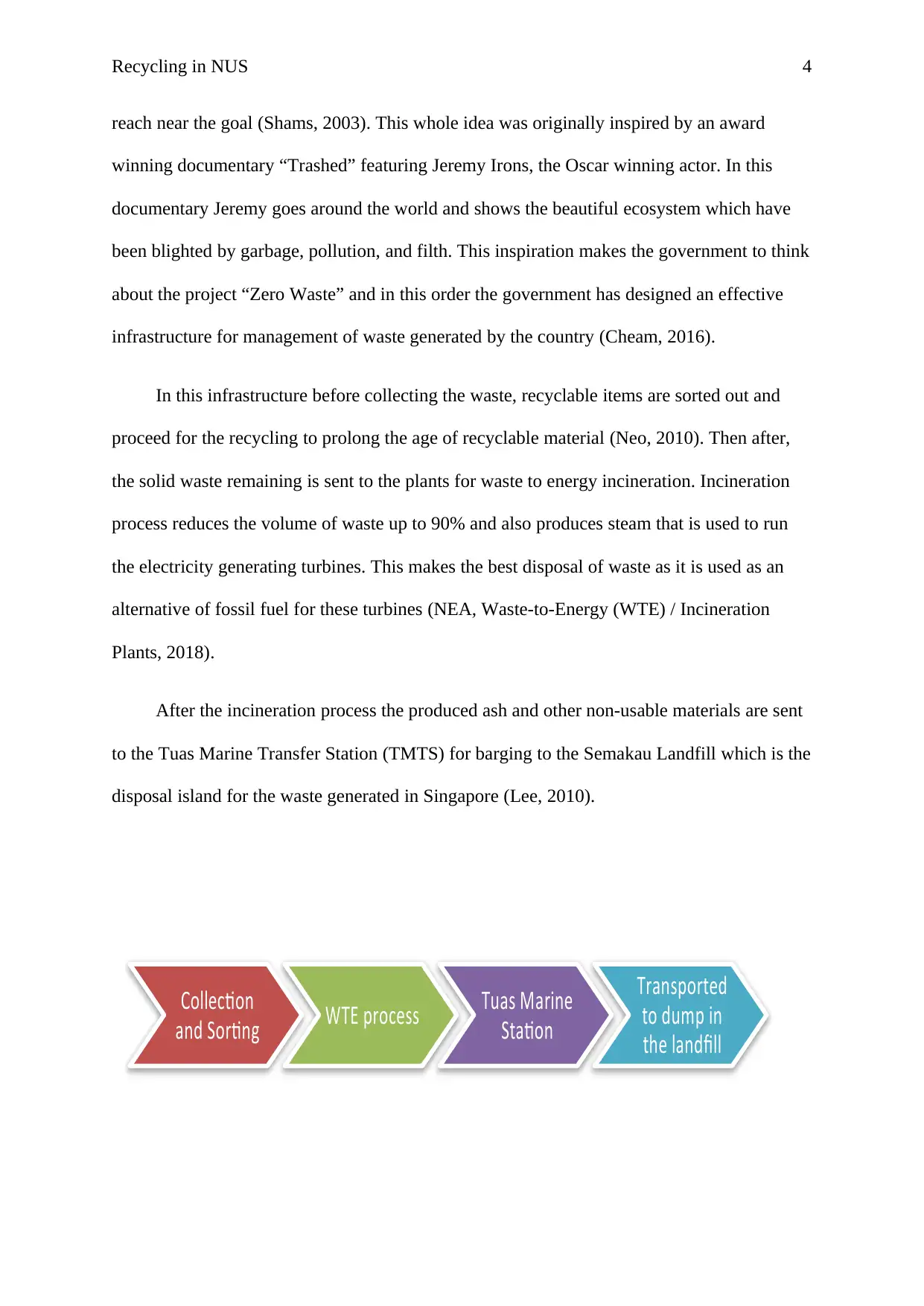
Recycling in NUS 4
reach near the goal (Shams, 2003). This whole idea was originally inspired by an award
winning documentary “Trashed” featuring Jeremy Irons, the Oscar winning actor. In this
documentary Jeremy goes around the world and shows the beautiful ecosystem which have
been blighted by garbage, pollution, and filth. This inspiration makes the government to think
about the project “Zero Waste” and in this order the government has designed an effective
infrastructure for management of waste generated by the country (Cheam, 2016).
In this infrastructure before collecting the waste, recyclable items are sorted out and
proceed for the recycling to prolong the age of recyclable material (Neo, 2010). Then after,
the solid waste remaining is sent to the plants for waste to energy incineration. Incineration
process reduces the volume of waste up to 90% and also produces steam that is used to run
the electricity generating turbines. This makes the best disposal of waste as it is used as an
alternative of fossil fuel for these turbines (NEA, Waste-to-Energy (WTE) / Incineration
Plants, 2018).
After the incineration process the produced ash and other non-usable materials are sent
to the Tuas Marine Transfer Station (TMTS) for barging to the Semakau Landfill which is the
disposal island for the waste generated in Singapore (Lee, 2010).
Collection
and Sorting WTE process Tuas Marine
Station
Transported
to dump in
the landfill
reach near the goal (Shams, 2003). This whole idea was originally inspired by an award
winning documentary “Trashed” featuring Jeremy Irons, the Oscar winning actor. In this
documentary Jeremy goes around the world and shows the beautiful ecosystem which have
been blighted by garbage, pollution, and filth. This inspiration makes the government to think
about the project “Zero Waste” and in this order the government has designed an effective
infrastructure for management of waste generated by the country (Cheam, 2016).
In this infrastructure before collecting the waste, recyclable items are sorted out and
proceed for the recycling to prolong the age of recyclable material (Neo, 2010). Then after,
the solid waste remaining is sent to the plants for waste to energy incineration. Incineration
process reduces the volume of waste up to 90% and also produces steam that is used to run
the electricity generating turbines. This makes the best disposal of waste as it is used as an
alternative of fossil fuel for these turbines (NEA, Waste-to-Energy (WTE) / Incineration
Plants, 2018).
After the incineration process the produced ash and other non-usable materials are sent
to the Tuas Marine Transfer Station (TMTS) for barging to the Semakau Landfill which is the
disposal island for the waste generated in Singapore (Lee, 2010).
Collection
and Sorting WTE process Tuas Marine
Station
Transported
to dump in
the landfill
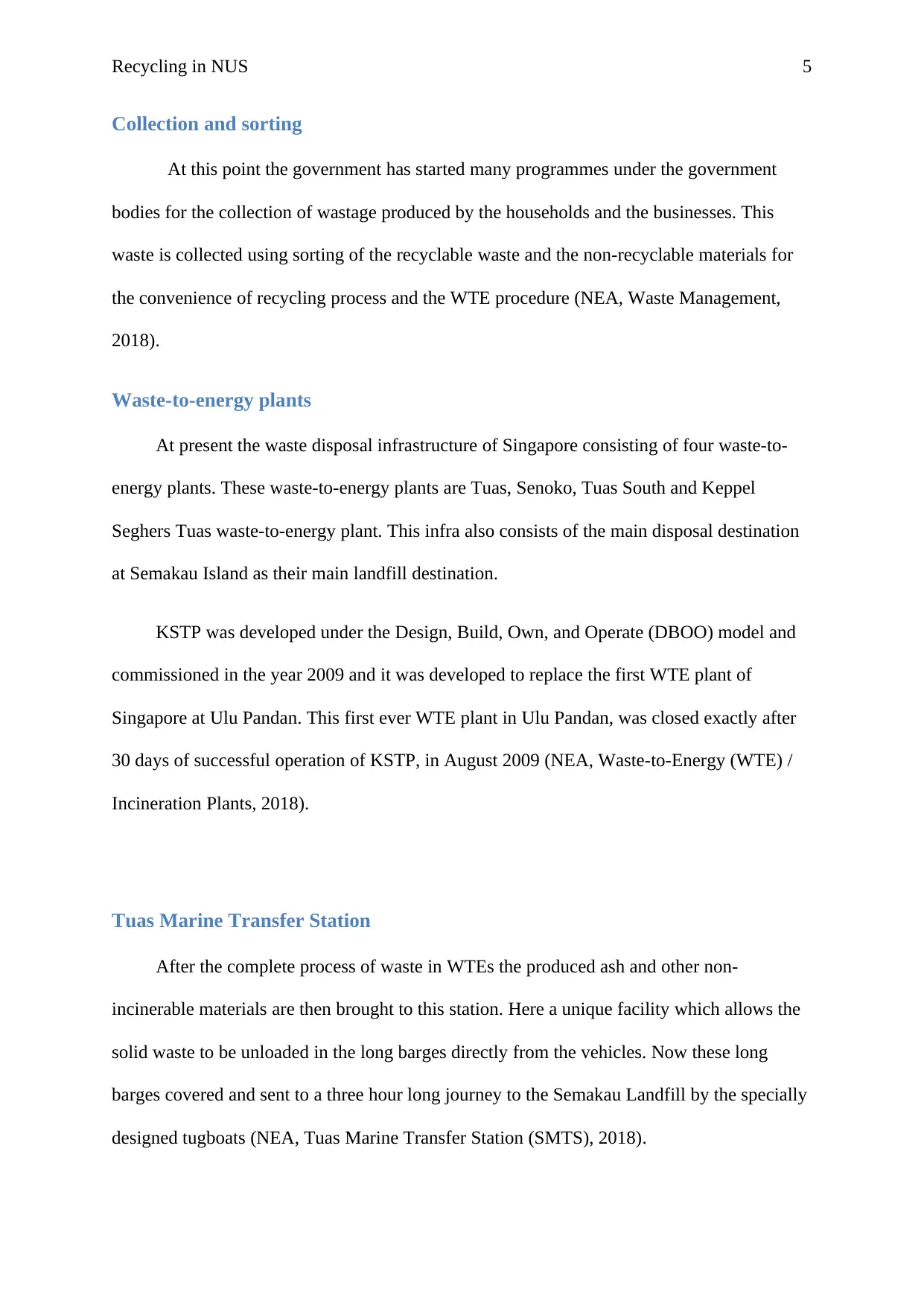
Recycling in NUS 5
Collection and sorting
At this point the government has started many programmes under the government
bodies for the collection of wastage produced by the households and the businesses. This
waste is collected using sorting of the recyclable waste and the non-recyclable materials for
the convenience of recycling process and the WTE procedure (NEA, Waste Management,
2018).
Waste-to-energy plants
At present the waste disposal infrastructure of Singapore consisting of four waste-to-
energy plants. These waste-to-energy plants are Tuas, Senoko, Tuas South and Keppel
Seghers Tuas waste-to-energy plant. This infra also consists of the main disposal destination
at Semakau Island as their main landfill destination.
KSTP was developed under the Design, Build, Own, and Operate (DBOO) model and
commissioned in the year 2009 and it was developed to replace the first WTE plant of
Singapore at Ulu Pandan. This first ever WTE plant in Ulu Pandan, was closed exactly after
30 days of successful operation of KSTP, in August 2009 (NEA, Waste-to-Energy (WTE) /
Incineration Plants, 2018).
Tuas Marine Transfer Station
After the complete process of waste in WTEs the produced ash and other non-
incinerable materials are then brought to this station. Here a unique facility which allows the
solid waste to be unloaded in the long barges directly from the vehicles. Now these long
barges covered and sent to a three hour long journey to the Semakau Landfill by the specially
designed tugboats (NEA, Tuas Marine Transfer Station (SMTS), 2018).
Collection and sorting
At this point the government has started many programmes under the government
bodies for the collection of wastage produced by the households and the businesses. This
waste is collected using sorting of the recyclable waste and the non-recyclable materials for
the convenience of recycling process and the WTE procedure (NEA, Waste Management,
2018).
Waste-to-energy plants
At present the waste disposal infrastructure of Singapore consisting of four waste-to-
energy plants. These waste-to-energy plants are Tuas, Senoko, Tuas South and Keppel
Seghers Tuas waste-to-energy plant. This infra also consists of the main disposal destination
at Semakau Island as their main landfill destination.
KSTP was developed under the Design, Build, Own, and Operate (DBOO) model and
commissioned in the year 2009 and it was developed to replace the first WTE plant of
Singapore at Ulu Pandan. This first ever WTE plant in Ulu Pandan, was closed exactly after
30 days of successful operation of KSTP, in August 2009 (NEA, Waste-to-Energy (WTE) /
Incineration Plants, 2018).
Tuas Marine Transfer Station
After the complete process of waste in WTEs the produced ash and other non-
incinerable materials are then brought to this station. Here a unique facility which allows the
solid waste to be unloaded in the long barges directly from the vehicles. Now these long
barges covered and sent to a three hour long journey to the Semakau Landfill by the specially
designed tugboats (NEA, Tuas Marine Transfer Station (SMTS), 2018).
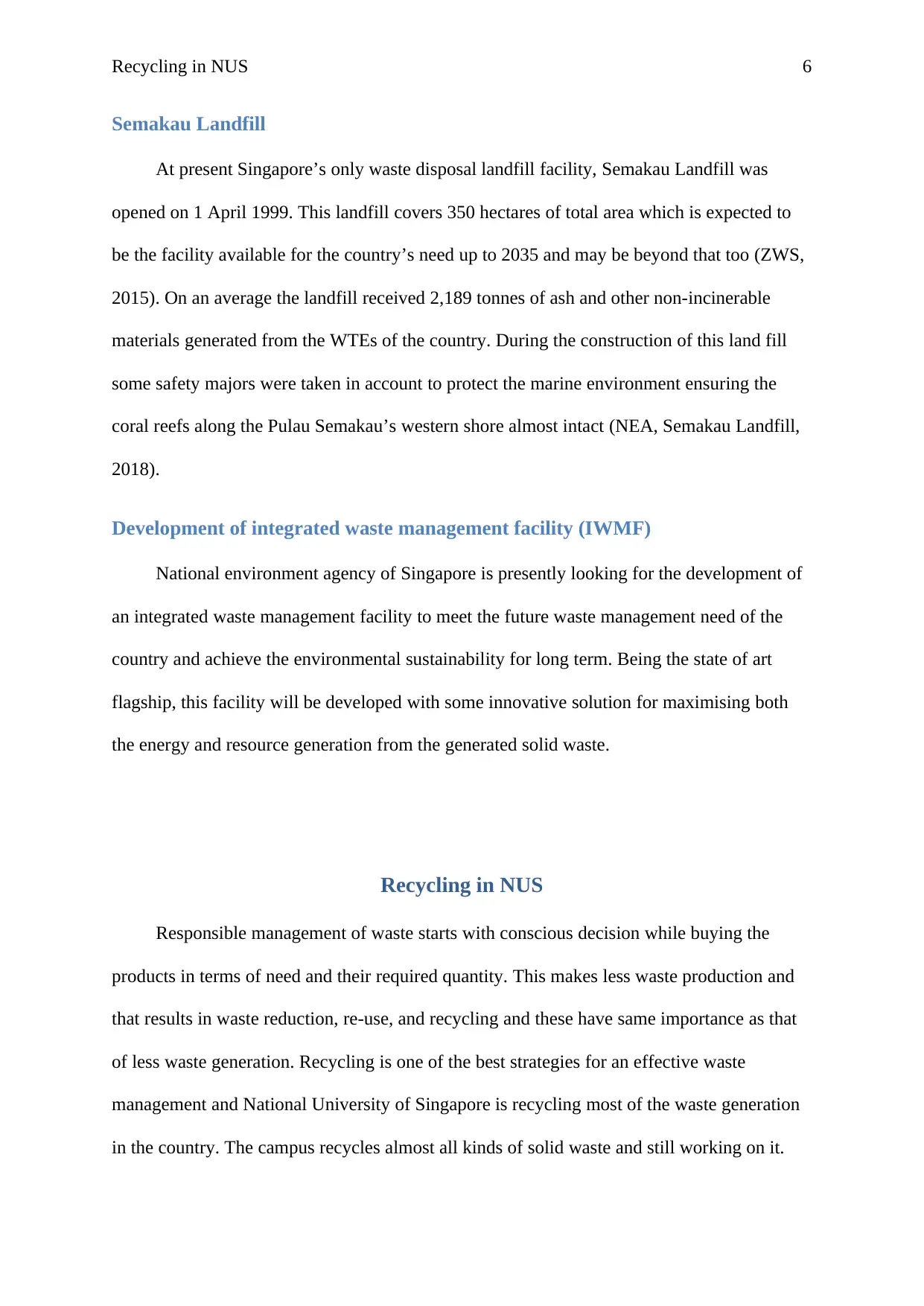
Recycling in NUS 6
Semakau Landfill
At present Singapore’s only waste disposal landfill facility, Semakau Landfill was
opened on 1 April 1999. This landfill covers 350 hectares of total area which is expected to
be the facility available for the country’s need up to 2035 and may be beyond that too (ZWS,
2015). On an average the landfill received 2,189 tonnes of ash and other non-incinerable
materials generated from the WTEs of the country. During the construction of this land fill
some safety majors were taken in account to protect the marine environment ensuring the
coral reefs along the Pulau Semakau’s western shore almost intact (NEA, Semakau Landfill,
2018).
Development of integrated waste management facility (IWMF)
National environment agency of Singapore is presently looking for the development of
an integrated waste management facility to meet the future waste management need of the
country and achieve the environmental sustainability for long term. Being the state of art
flagship, this facility will be developed with some innovative solution for maximising both
the energy and resource generation from the generated solid waste.
Recycling in NUS
Responsible management of waste starts with conscious decision while buying the
products in terms of need and their required quantity. This makes less waste production and
that results in waste reduction, re-use, and recycling and these have same importance as that
of less waste generation. Recycling is one of the best strategies for an effective waste
management and National University of Singapore is recycling most of the waste generation
in the country. The campus recycles almost all kinds of solid waste and still working on it.
Semakau Landfill
At present Singapore’s only waste disposal landfill facility, Semakau Landfill was
opened on 1 April 1999. This landfill covers 350 hectares of total area which is expected to
be the facility available for the country’s need up to 2035 and may be beyond that too (ZWS,
2015). On an average the landfill received 2,189 tonnes of ash and other non-incinerable
materials generated from the WTEs of the country. During the construction of this land fill
some safety majors were taken in account to protect the marine environment ensuring the
coral reefs along the Pulau Semakau’s western shore almost intact (NEA, Semakau Landfill,
2018).
Development of integrated waste management facility (IWMF)
National environment agency of Singapore is presently looking for the development of
an integrated waste management facility to meet the future waste management need of the
country and achieve the environmental sustainability for long term. Being the state of art
flagship, this facility will be developed with some innovative solution for maximising both
the energy and resource generation from the generated solid waste.
Recycling in NUS
Responsible management of waste starts with conscious decision while buying the
products in terms of need and their required quantity. This makes less waste production and
that results in waste reduction, re-use, and recycling and these have same importance as that
of less waste generation. Recycling is one of the best strategies for an effective waste
management and National University of Singapore is recycling most of the waste generation
in the country. The campus recycles almost all kinds of solid waste and still working on it.
Paraphrase This Document
Need a fresh take? Get an instant paraphrase of this document with our AI Paraphraser
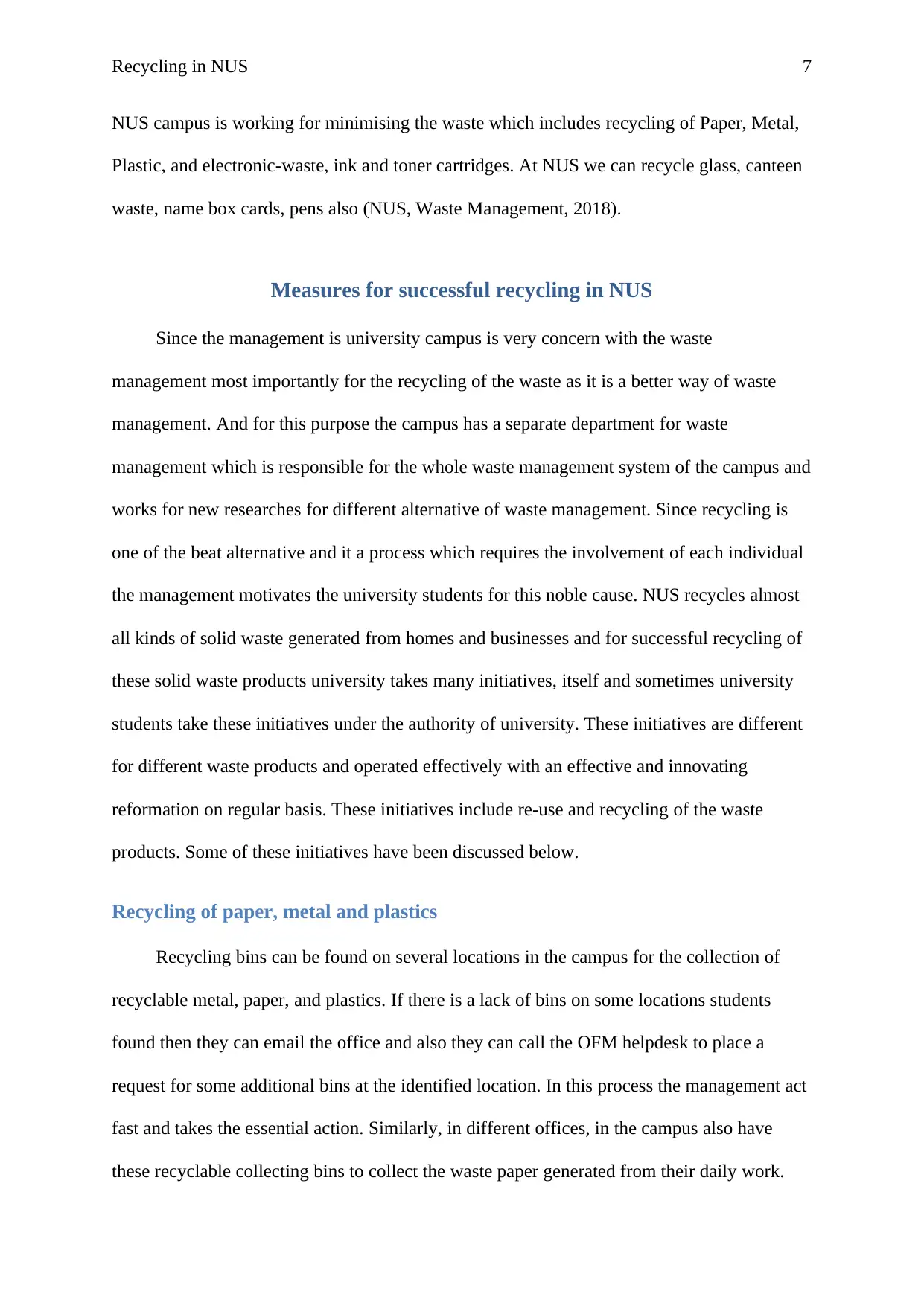
Recycling in NUS 7
NUS campus is working for minimising the waste which includes recycling of Paper, Metal,
Plastic, and electronic-waste, ink and toner cartridges. At NUS we can recycle glass, canteen
waste, name box cards, pens also (NUS, Waste Management, 2018).
Measures for successful recycling in NUS
Since the management is university campus is very concern with the waste
management most importantly for the recycling of the waste as it is a better way of waste
management. And for this purpose the campus has a separate department for waste
management which is responsible for the whole waste management system of the campus and
works for new researches for different alternative of waste management. Since recycling is
one of the beat alternative and it a process which requires the involvement of each individual
the management motivates the university students for this noble cause. NUS recycles almost
all kinds of solid waste generated from homes and businesses and for successful recycling of
these solid waste products university takes many initiatives, itself and sometimes university
students take these initiatives under the authority of university. These initiatives are different
for different waste products and operated effectively with an effective and innovating
reformation on regular basis. These initiatives include re-use and recycling of the waste
products. Some of these initiatives have been discussed below.
Recycling of paper, metal and plastics
Recycling bins can be found on several locations in the campus for the collection of
recyclable metal, paper, and plastics. If there is a lack of bins on some locations students
found then they can email the office and also they can call the OFM helpdesk to place a
request for some additional bins at the identified location. In this process the management act
fast and takes the essential action. Similarly, in different offices, in the campus also have
these recyclable collecting bins to collect the waste paper generated from their daily work.
NUS campus is working for minimising the waste which includes recycling of Paper, Metal,
Plastic, and electronic-waste, ink and toner cartridges. At NUS we can recycle glass, canteen
waste, name box cards, pens also (NUS, Waste Management, 2018).
Measures for successful recycling in NUS
Since the management is university campus is very concern with the waste
management most importantly for the recycling of the waste as it is a better way of waste
management. And for this purpose the campus has a separate department for waste
management which is responsible for the whole waste management system of the campus and
works for new researches for different alternative of waste management. Since recycling is
one of the beat alternative and it a process which requires the involvement of each individual
the management motivates the university students for this noble cause. NUS recycles almost
all kinds of solid waste generated from homes and businesses and for successful recycling of
these solid waste products university takes many initiatives, itself and sometimes university
students take these initiatives under the authority of university. These initiatives are different
for different waste products and operated effectively with an effective and innovating
reformation on regular basis. These initiatives include re-use and recycling of the waste
products. Some of these initiatives have been discussed below.
Recycling of paper, metal and plastics
Recycling bins can be found on several locations in the campus for the collection of
recyclable metal, paper, and plastics. If there is a lack of bins on some locations students
found then they can email the office and also they can call the OFM helpdesk to place a
request for some additional bins at the identified location. In this process the management act
fast and takes the essential action. Similarly, in different offices, in the campus also have
these recyclable collecting bins to collect the waste paper generated from their daily work.
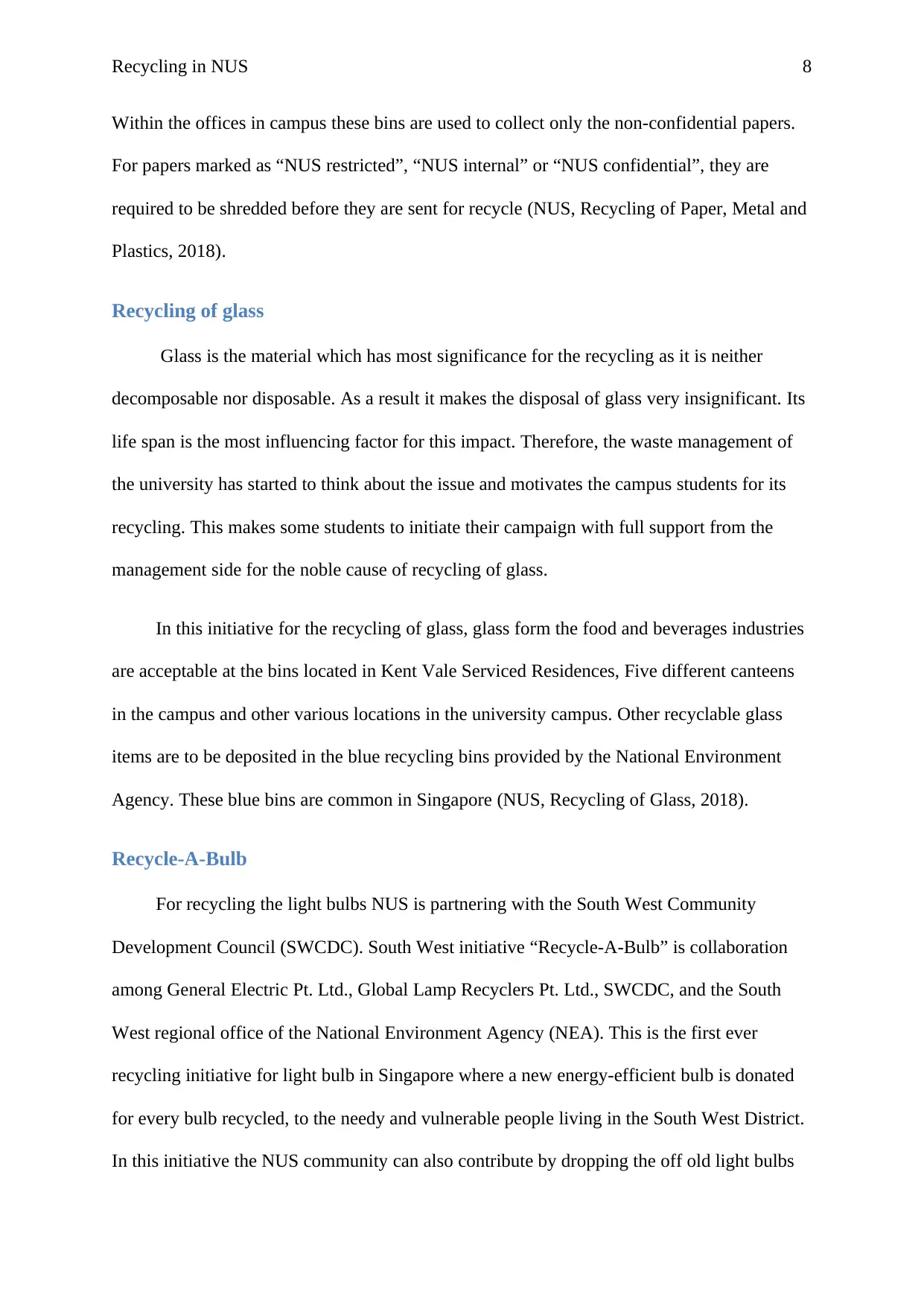
Recycling in NUS 8
Within the offices in campus these bins are used to collect only the non-confidential papers.
For papers marked as “NUS restricted”, “NUS internal” or “NUS confidential”, they are
required to be shredded before they are sent for recycle (NUS, Recycling of Paper, Metal and
Plastics, 2018).
Recycling of glass
Glass is the material which has most significance for the recycling as it is neither
decomposable nor disposable. As a result it makes the disposal of glass very insignificant. Its
life span is the most influencing factor for this impact. Therefore, the waste management of
the university has started to think about the issue and motivates the campus students for its
recycling. This makes some students to initiate their campaign with full support from the
management side for the noble cause of recycling of glass.
In this initiative for the recycling of glass, glass form the food and beverages industries
are acceptable at the bins located in Kent Vale Serviced Residences, Five different canteens
in the campus and other various locations in the university campus. Other recyclable glass
items are to be deposited in the blue recycling bins provided by the National Environment
Agency. These blue bins are common in Singapore (NUS, Recycling of Glass, 2018).
Recycle-A-Bulb
For recycling the light bulbs NUS is partnering with the South West Community
Development Council (SWCDC). South West initiative “Recycle-A-Bulb” is collaboration
among General Electric Pt. Ltd., Global Lamp Recyclers Pt. Ltd., SWCDC, and the South
West regional office of the National Environment Agency (NEA). This is the first ever
recycling initiative for light bulb in Singapore where a new energy-efficient bulb is donated
for every bulb recycled, to the needy and vulnerable people living in the South West District.
In this initiative the NUS community can also contribute by dropping the off old light bulbs
Within the offices in campus these bins are used to collect only the non-confidential papers.
For papers marked as “NUS restricted”, “NUS internal” or “NUS confidential”, they are
required to be shredded before they are sent for recycle (NUS, Recycling of Paper, Metal and
Plastics, 2018).
Recycling of glass
Glass is the material which has most significance for the recycling as it is neither
decomposable nor disposable. As a result it makes the disposal of glass very insignificant. Its
life span is the most influencing factor for this impact. Therefore, the waste management of
the university has started to think about the issue and motivates the campus students for its
recycling. This makes some students to initiate their campaign with full support from the
management side for the noble cause of recycling of glass.
In this initiative for the recycling of glass, glass form the food and beverages industries
are acceptable at the bins located in Kent Vale Serviced Residences, Five different canteens
in the campus and other various locations in the university campus. Other recyclable glass
items are to be deposited in the blue recycling bins provided by the National Environment
Agency. These blue bins are common in Singapore (NUS, Recycling of Glass, 2018).
Recycle-A-Bulb
For recycling the light bulbs NUS is partnering with the South West Community
Development Council (SWCDC). South West initiative “Recycle-A-Bulb” is collaboration
among General Electric Pt. Ltd., Global Lamp Recyclers Pt. Ltd., SWCDC, and the South
West regional office of the National Environment Agency (NEA). This is the first ever
recycling initiative for light bulb in Singapore where a new energy-efficient bulb is donated
for every bulb recycled, to the needy and vulnerable people living in the South West District.
In this initiative the NUS community can also contribute by dropping the off old light bulbs
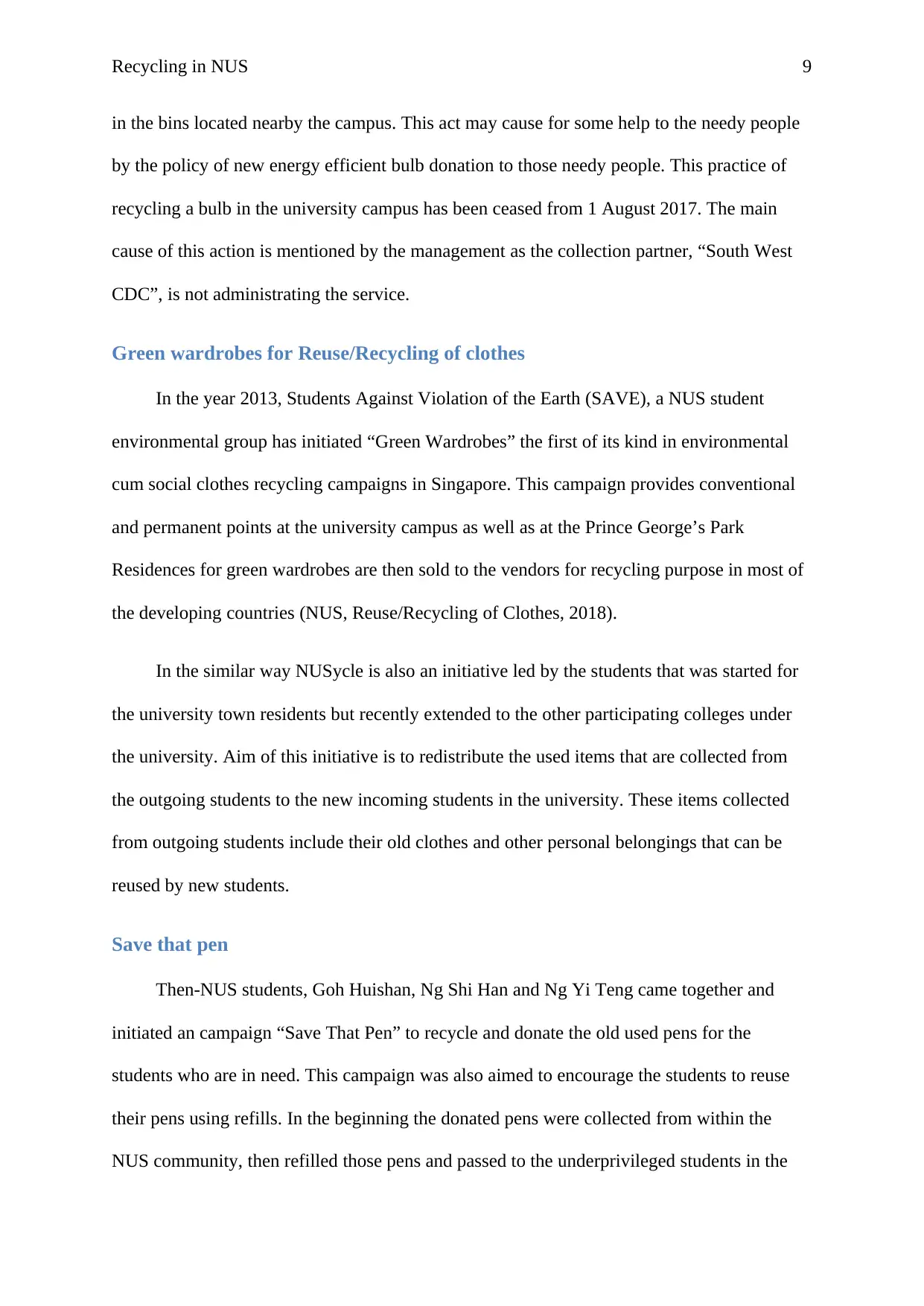
Recycling in NUS 9
in the bins located nearby the campus. This act may cause for some help to the needy people
by the policy of new energy efficient bulb donation to those needy people. This practice of
recycling a bulb in the university campus has been ceased from 1 August 2017. The main
cause of this action is mentioned by the management as the collection partner, “South West
CDC”, is not administrating the service.
Green wardrobes for Reuse/Recycling of clothes
In the year 2013, Students Against Violation of the Earth (SAVE), a NUS student
environmental group has initiated “Green Wardrobes” the first of its kind in environmental
cum social clothes recycling campaigns in Singapore. This campaign provides conventional
and permanent points at the university campus as well as at the Prince George’s Park
Residences for green wardrobes are then sold to the vendors for recycling purpose in most of
the developing countries (NUS, Reuse/Recycling of Clothes, 2018).
In the similar way NUSycle is also an initiative led by the students that was started for
the university town residents but recently extended to the other participating colleges under
the university. Aim of this initiative is to redistribute the used items that are collected from
the outgoing students to the new incoming students in the university. These items collected
from outgoing students include their old clothes and other personal belongings that can be
reused by new students.
Save that pen
Then-NUS students, Goh Huishan, Ng Shi Han and Ng Yi Teng came together and
initiated an campaign “Save That Pen” to recycle and donate the old used pens for the
students who are in need. This campaign was also aimed to encourage the students to reuse
their pens using refills. In the beginning the donated pens were collected from within the
NUS community, then refilled those pens and passed to the underprivileged students in the
in the bins located nearby the campus. This act may cause for some help to the needy people
by the policy of new energy efficient bulb donation to those needy people. This practice of
recycling a bulb in the university campus has been ceased from 1 August 2017. The main
cause of this action is mentioned by the management as the collection partner, “South West
CDC”, is not administrating the service.
Green wardrobes for Reuse/Recycling of clothes
In the year 2013, Students Against Violation of the Earth (SAVE), a NUS student
environmental group has initiated “Green Wardrobes” the first of its kind in environmental
cum social clothes recycling campaigns in Singapore. This campaign provides conventional
and permanent points at the university campus as well as at the Prince George’s Park
Residences for green wardrobes are then sold to the vendors for recycling purpose in most of
the developing countries (NUS, Reuse/Recycling of Clothes, 2018).
In the similar way NUSycle is also an initiative led by the students that was started for
the university town residents but recently extended to the other participating colleges under
the university. Aim of this initiative is to redistribute the used items that are collected from
the outgoing students to the new incoming students in the university. These items collected
from outgoing students include their old clothes and other personal belongings that can be
reused by new students.
Save that pen
Then-NUS students, Goh Huishan, Ng Shi Han and Ng Yi Teng came together and
initiated an campaign “Save That Pen” to recycle and donate the old used pens for the
students who are in need. This campaign was also aimed to encourage the students to reuse
their pens using refills. In the beginning the donated pens were collected from within the
NUS community, then refilled those pens and passed to the underprivileged students in the
Secure Best Marks with AI Grader
Need help grading? Try our AI Grader for instant feedback on your assignments.
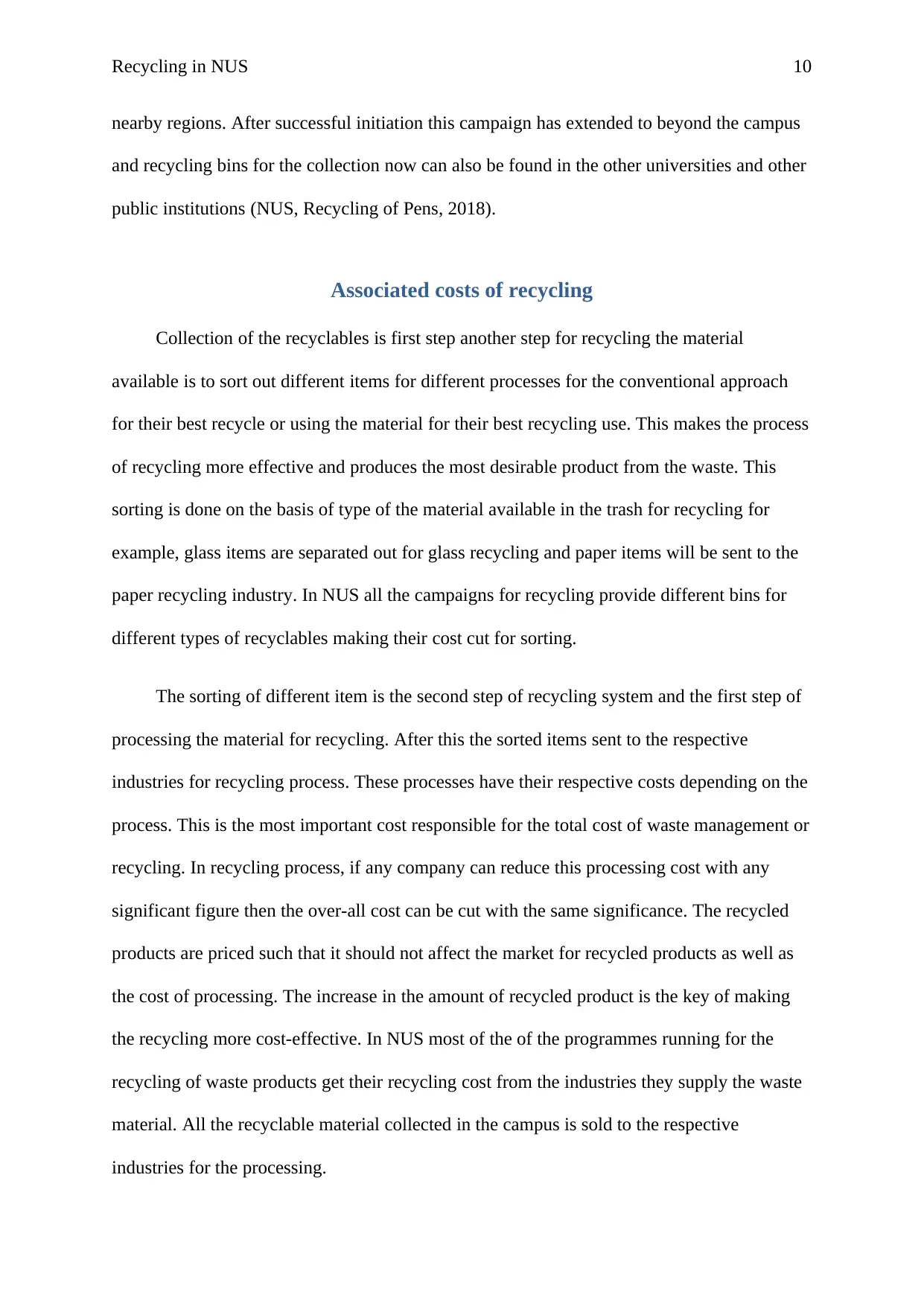
Recycling in NUS 10
nearby regions. After successful initiation this campaign has extended to beyond the campus
and recycling bins for the collection now can also be found in the other universities and other
public institutions (NUS, Recycling of Pens, 2018).
Associated costs of recycling
Collection of the recyclables is first step another step for recycling the material
available is to sort out different items for different processes for the conventional approach
for their best recycle or using the material for their best recycling use. This makes the process
of recycling more effective and produces the most desirable product from the waste. This
sorting is done on the basis of type of the material available in the trash for recycling for
example, glass items are separated out for glass recycling and paper items will be sent to the
paper recycling industry. In NUS all the campaigns for recycling provide different bins for
different types of recyclables making their cost cut for sorting.
The sorting of different item is the second step of recycling system and the first step of
processing the material for recycling. After this the sorted items sent to the respective
industries for recycling process. These processes have their respective costs depending on the
process. This is the most important cost responsible for the total cost of waste management or
recycling. In recycling process, if any company can reduce this processing cost with any
significant figure then the over-all cost can be cut with the same significance. The recycled
products are priced such that it should not affect the market for recycled products as well as
the cost of processing. The increase in the amount of recycled product is the key of making
the recycling more cost-effective. In NUS most of the of the programmes running for the
recycling of waste products get their recycling cost from the industries they supply the waste
material. All the recyclable material collected in the campus is sold to the respective
industries for the processing.
nearby regions. After successful initiation this campaign has extended to beyond the campus
and recycling bins for the collection now can also be found in the other universities and other
public institutions (NUS, Recycling of Pens, 2018).
Associated costs of recycling
Collection of the recyclables is first step another step for recycling the material
available is to sort out different items for different processes for the conventional approach
for their best recycle or using the material for their best recycling use. This makes the process
of recycling more effective and produces the most desirable product from the waste. This
sorting is done on the basis of type of the material available in the trash for recycling for
example, glass items are separated out for glass recycling and paper items will be sent to the
paper recycling industry. In NUS all the campaigns for recycling provide different bins for
different types of recyclables making their cost cut for sorting.
The sorting of different item is the second step of recycling system and the first step of
processing the material for recycling. After this the sorted items sent to the respective
industries for recycling process. These processes have their respective costs depending on the
process. This is the most important cost responsible for the total cost of waste management or
recycling. In recycling process, if any company can reduce this processing cost with any
significant figure then the over-all cost can be cut with the same significance. The recycled
products are priced such that it should not affect the market for recycled products as well as
the cost of processing. The increase in the amount of recycled product is the key of making
the recycling more cost-effective. In NUS most of the of the programmes running for the
recycling of waste products get their recycling cost from the industries they supply the waste
material. All the recyclable material collected in the campus is sold to the respective
industries for the processing.
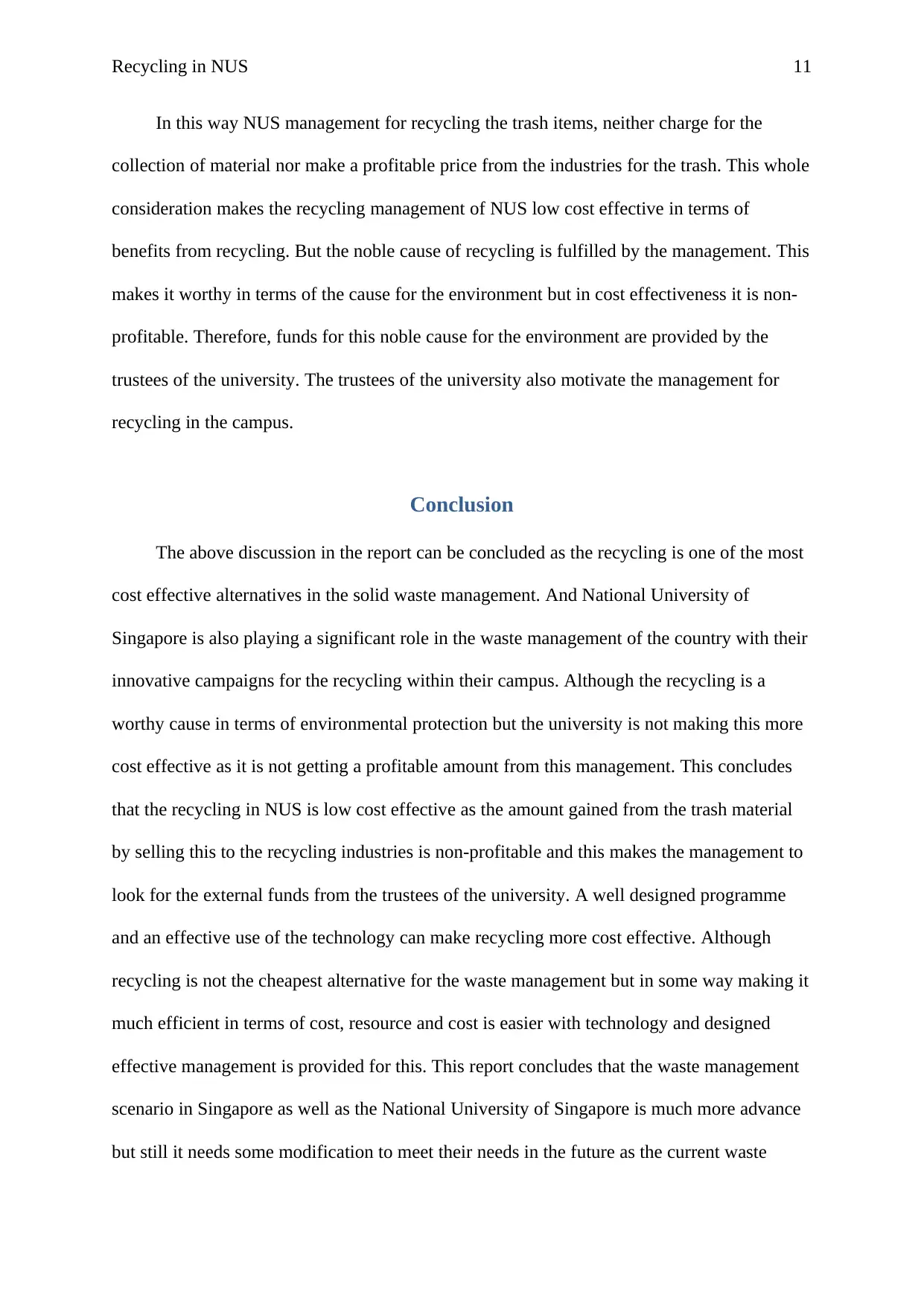
Recycling in NUS 11
In this way NUS management for recycling the trash items, neither charge for the
collection of material nor make a profitable price from the industries for the trash. This whole
consideration makes the recycling management of NUS low cost effective in terms of
benefits from recycling. But the noble cause of recycling is fulfilled by the management. This
makes it worthy in terms of the cause for the environment but in cost effectiveness it is non-
profitable. Therefore, funds for this noble cause for the environment are provided by the
trustees of the university. The trustees of the university also motivate the management for
recycling in the campus.
Conclusion
The above discussion in the report can be concluded as the recycling is one of the most
cost effective alternatives in the solid waste management. And National University of
Singapore is also playing a significant role in the waste management of the country with their
innovative campaigns for the recycling within their campus. Although the recycling is a
worthy cause in terms of environmental protection but the university is not making this more
cost effective as it is not getting a profitable amount from this management. This concludes
that the recycling in NUS is low cost effective as the amount gained from the trash material
by selling this to the recycling industries is non-profitable and this makes the management to
look for the external funds from the trustees of the university. A well designed programme
and an effective use of the technology can make recycling more cost effective. Although
recycling is not the cheapest alternative for the waste management but in some way making it
much efficient in terms of cost, resource and cost is easier with technology and designed
effective management is provided for this. This report concludes that the waste management
scenario in Singapore as well as the National University of Singapore is much more advance
but still it needs some modification to meet their needs in the future as the current waste
In this way NUS management for recycling the trash items, neither charge for the
collection of material nor make a profitable price from the industries for the trash. This whole
consideration makes the recycling management of NUS low cost effective in terms of
benefits from recycling. But the noble cause of recycling is fulfilled by the management. This
makes it worthy in terms of the cause for the environment but in cost effectiveness it is non-
profitable. Therefore, funds for this noble cause for the environment are provided by the
trustees of the university. The trustees of the university also motivate the management for
recycling in the campus.
Conclusion
The above discussion in the report can be concluded as the recycling is one of the most
cost effective alternatives in the solid waste management. And National University of
Singapore is also playing a significant role in the waste management of the country with their
innovative campaigns for the recycling within their campus. Although the recycling is a
worthy cause in terms of environmental protection but the university is not making this more
cost effective as it is not getting a profitable amount from this management. This concludes
that the recycling in NUS is low cost effective as the amount gained from the trash material
by selling this to the recycling industries is non-profitable and this makes the management to
look for the external funds from the trustees of the university. A well designed programme
and an effective use of the technology can make recycling more cost effective. Although
recycling is not the cheapest alternative for the waste management but in some way making it
much efficient in terms of cost, resource and cost is easier with technology and designed
effective management is provided for this. This report concludes that the waste management
scenario in Singapore as well as the National University of Singapore is much more advance
but still it needs some modification to meet their needs in the future as the current waste
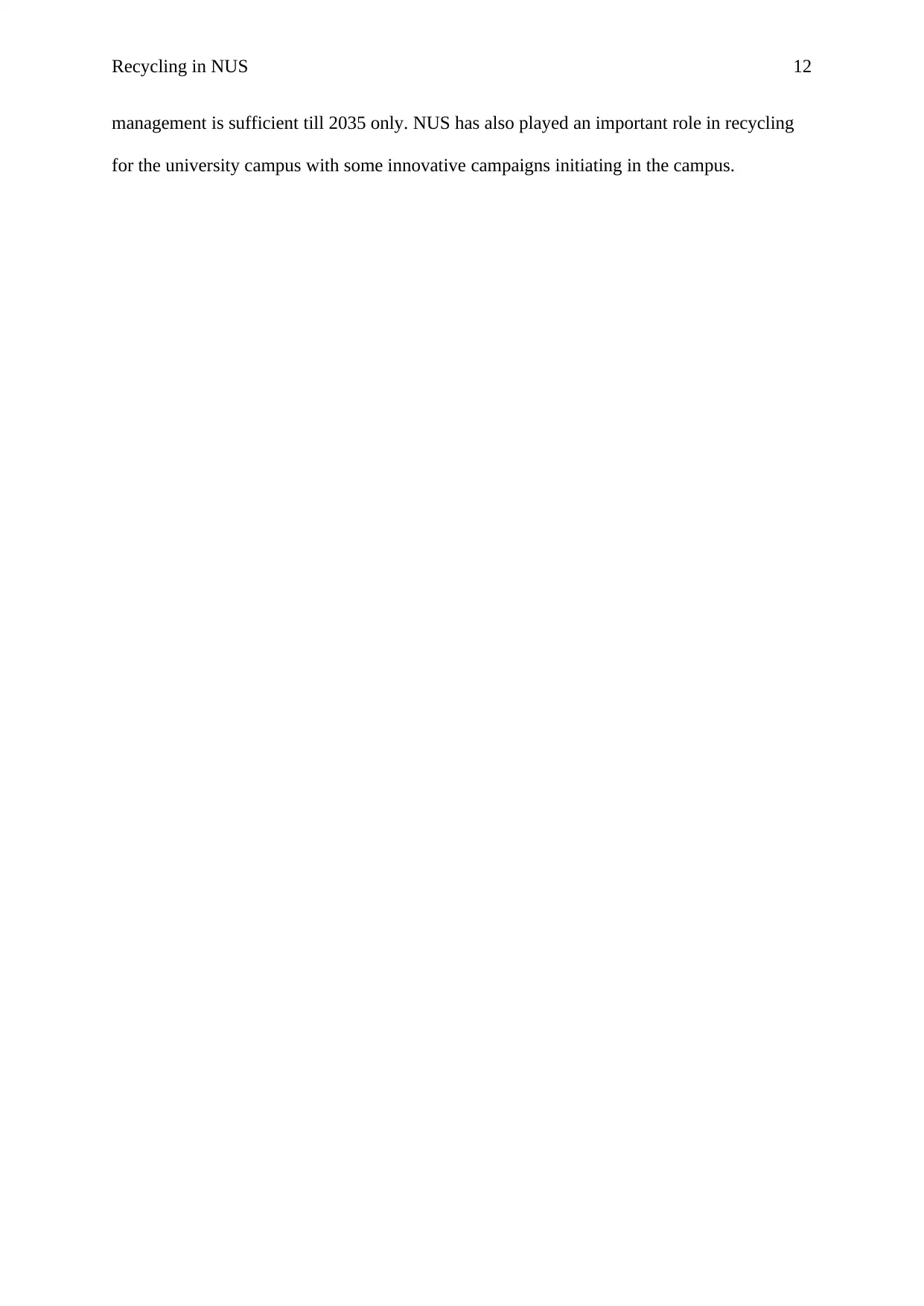
Recycling in NUS 12
management is sufficient till 2035 only. NUS has also played an important role in recycling
for the university campus with some innovative campaigns initiating in the campus.
management is sufficient till 2035 only. NUS has also played an important role in recycling
for the university campus with some innovative campaigns initiating in the campus.
Paraphrase This Document
Need a fresh take? Get an instant paraphrase of this document with our AI Paraphraser
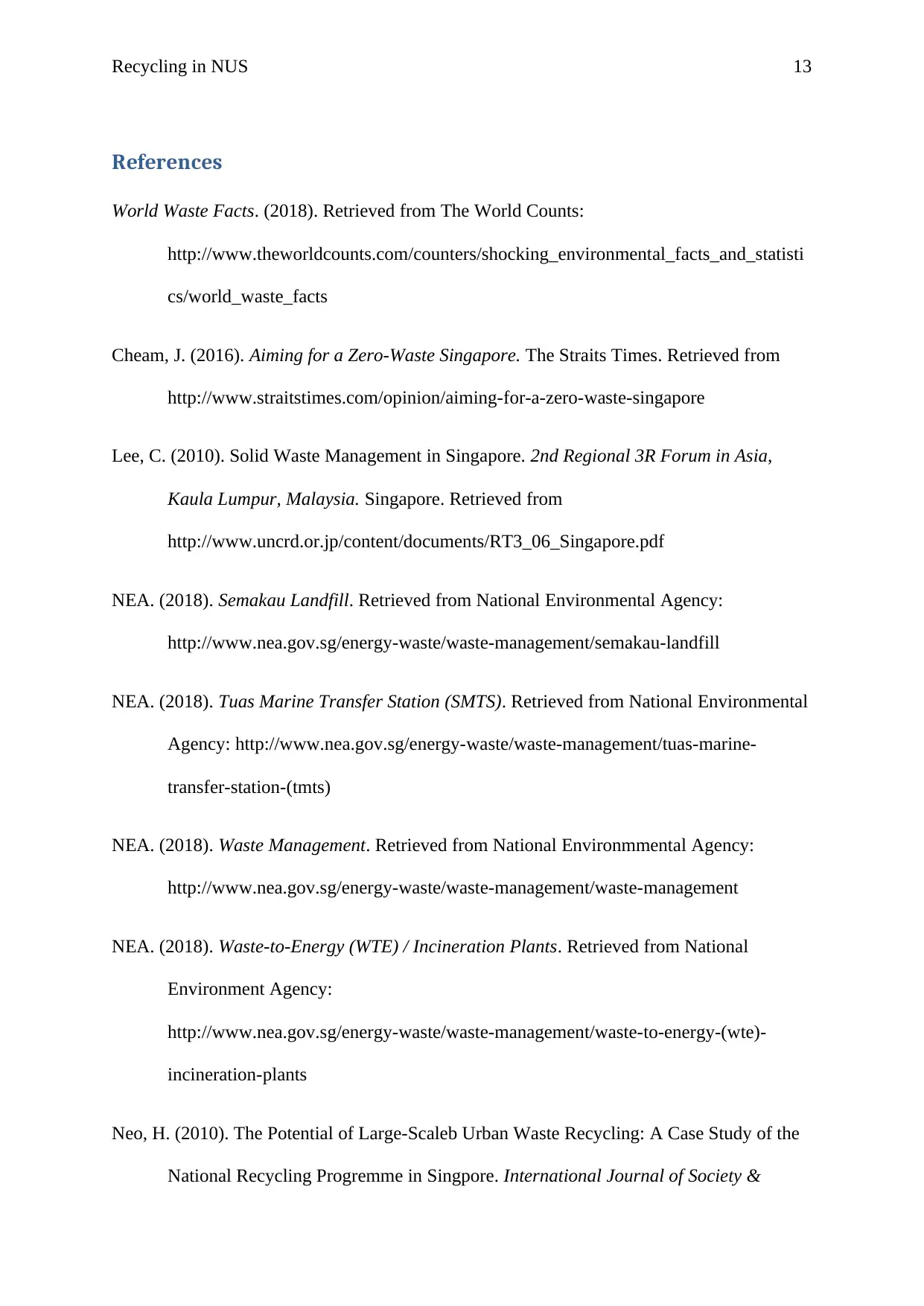
Recycling in NUS 13
References
World Waste Facts. (2018). Retrieved from The World Counts:
http://www.theworldcounts.com/counters/shocking_environmental_facts_and_statisti
cs/world_waste_facts
Cheam, J. (2016). Aiming for a Zero-Waste Singapore. The Straits Times. Retrieved from
http://www.straitstimes.com/opinion/aiming-for-a-zero-waste-singapore
Lee, C. (2010). Solid Waste Management in Singapore. 2nd Regional 3R Forum in Asia,
Kaula Lumpur, Malaysia. Singapore. Retrieved from
http://www.uncrd.or.jp/content/documents/RT3_06_Singapore.pdf
NEA. (2018). Semakau Landfill. Retrieved from National Environmental Agency:
http://www.nea.gov.sg/energy-waste/waste-management/semakau-landfill
NEA. (2018). Tuas Marine Transfer Station (SMTS). Retrieved from National Environmental
Agency: http://www.nea.gov.sg/energy-waste/waste-management/tuas-marine-
transfer-station-(tmts)
NEA. (2018). Waste Management. Retrieved from National Environmmental Agency:
http://www.nea.gov.sg/energy-waste/waste-management/waste-management
NEA. (2018). Waste-to-Energy (WTE) / Incineration Plants. Retrieved from National
Environment Agency:
http://www.nea.gov.sg/energy-waste/waste-management/waste-to-energy-(wte)-
incineration-plants
Neo, H. (2010). The Potential of Large-Scaleb Urban Waste Recycling: A Case Study of the
National Recycling Progremme in Singpore. International Journal of Society &
References
World Waste Facts. (2018). Retrieved from The World Counts:
http://www.theworldcounts.com/counters/shocking_environmental_facts_and_statisti
cs/world_waste_facts
Cheam, J. (2016). Aiming for a Zero-Waste Singapore. The Straits Times. Retrieved from
http://www.straitstimes.com/opinion/aiming-for-a-zero-waste-singapore
Lee, C. (2010). Solid Waste Management in Singapore. 2nd Regional 3R Forum in Asia,
Kaula Lumpur, Malaysia. Singapore. Retrieved from
http://www.uncrd.or.jp/content/documents/RT3_06_Singapore.pdf
NEA. (2018). Semakau Landfill. Retrieved from National Environmental Agency:
http://www.nea.gov.sg/energy-waste/waste-management/semakau-landfill
NEA. (2018). Tuas Marine Transfer Station (SMTS). Retrieved from National Environmental
Agency: http://www.nea.gov.sg/energy-waste/waste-management/tuas-marine-
transfer-station-(tmts)
NEA. (2018). Waste Management. Retrieved from National Environmmental Agency:
http://www.nea.gov.sg/energy-waste/waste-management/waste-management
NEA. (2018). Waste-to-Energy (WTE) / Incineration Plants. Retrieved from National
Environment Agency:
http://www.nea.gov.sg/energy-waste/waste-management/waste-to-energy-(wte)-
incineration-plants
Neo, H. (2010). The Potential of Large-Scaleb Urban Waste Recycling: A Case Study of the
National Recycling Progremme in Singpore. International Journal of Society &
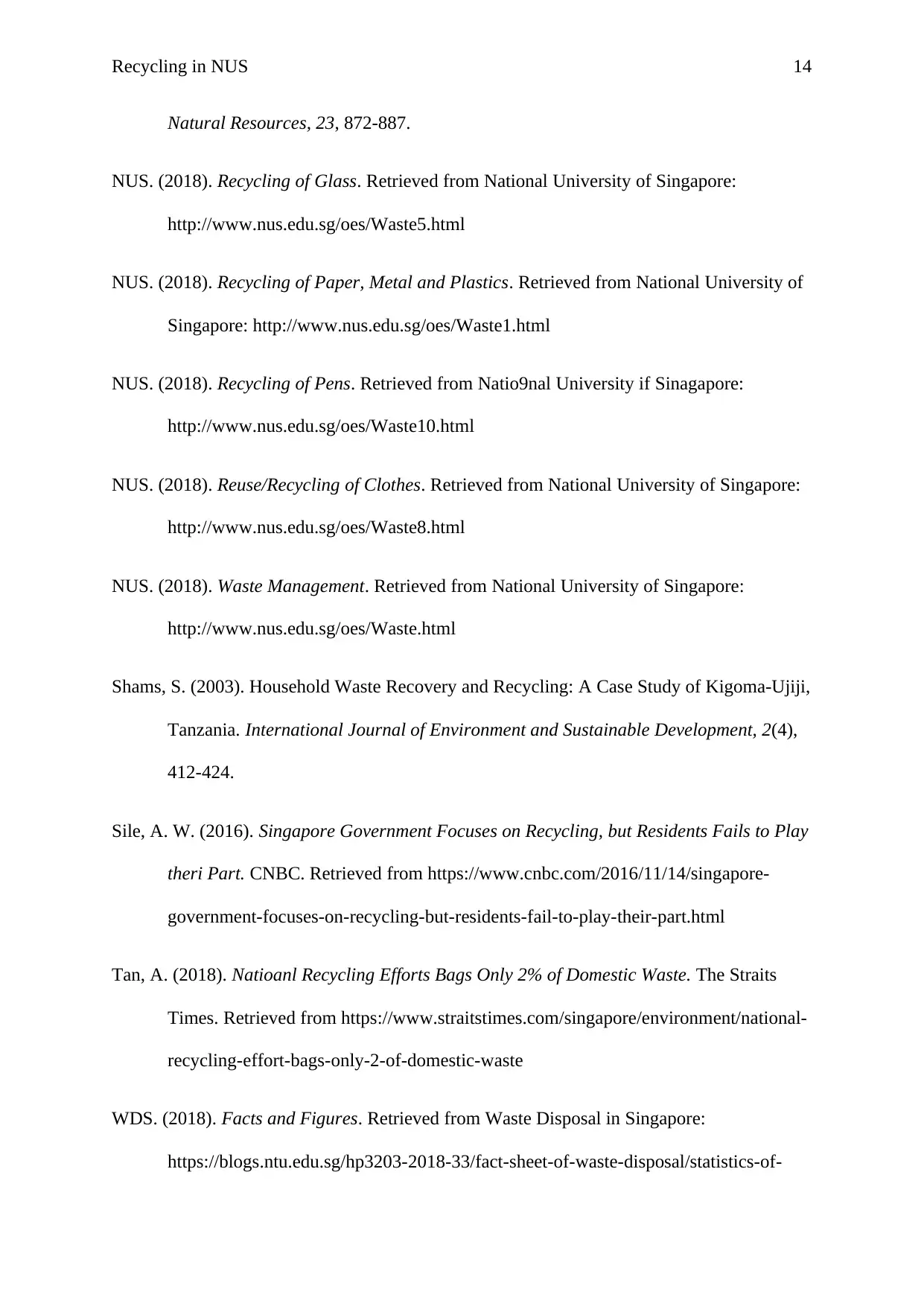
Recycling in NUS 14
Natural Resources, 23, 872-887.
NUS. (2018). Recycling of Glass. Retrieved from National University of Singapore:
http://www.nus.edu.sg/oes/Waste5.html
NUS. (2018). Recycling of Paper, Metal and Plastics. Retrieved from National University of
Singapore: http://www.nus.edu.sg/oes/Waste1.html
NUS. (2018). Recycling of Pens. Retrieved from Natio9nal University if Sinagapore:
http://www.nus.edu.sg/oes/Waste10.html
NUS. (2018). Reuse/Recycling of Clothes. Retrieved from National University of Singapore:
http://www.nus.edu.sg/oes/Waste8.html
NUS. (2018). Waste Management. Retrieved from National University of Singapore:
http://www.nus.edu.sg/oes/Waste.html
Shams, S. (2003). Household Waste Recovery and Recycling: A Case Study of Kigoma-Ujiji,
Tanzania. International Journal of Environment and Sustainable Development, 2(4),
412-424.
Sile, A. W. (2016). Singapore Government Focuses on Recycling, but Residents Fails to Play
theri Part. CNBC. Retrieved from https://www.cnbc.com/2016/11/14/singapore-
government-focuses-on-recycling-but-residents-fail-to-play-their-part.html
Tan, A. (2018). Natioanl Recycling Efforts Bags Only 2% of Domestic Waste. The Straits
Times. Retrieved from https://www.straitstimes.com/singapore/environment/national-
recycling-effort-bags-only-2-of-domestic-waste
WDS. (2018). Facts and Figures. Retrieved from Waste Disposal in Singapore:
https://blogs.ntu.edu.sg/hp3203-2018-33/fact-sheet-of-waste-disposal/statistics-of-
Natural Resources, 23, 872-887.
NUS. (2018). Recycling of Glass. Retrieved from National University of Singapore:
http://www.nus.edu.sg/oes/Waste5.html
NUS. (2018). Recycling of Paper, Metal and Plastics. Retrieved from National University of
Singapore: http://www.nus.edu.sg/oes/Waste1.html
NUS. (2018). Recycling of Pens. Retrieved from Natio9nal University if Sinagapore:
http://www.nus.edu.sg/oes/Waste10.html
NUS. (2018). Reuse/Recycling of Clothes. Retrieved from National University of Singapore:
http://www.nus.edu.sg/oes/Waste8.html
NUS. (2018). Waste Management. Retrieved from National University of Singapore:
http://www.nus.edu.sg/oes/Waste.html
Shams, S. (2003). Household Waste Recovery and Recycling: A Case Study of Kigoma-Ujiji,
Tanzania. International Journal of Environment and Sustainable Development, 2(4),
412-424.
Sile, A. W. (2016). Singapore Government Focuses on Recycling, but Residents Fails to Play
theri Part. CNBC. Retrieved from https://www.cnbc.com/2016/11/14/singapore-
government-focuses-on-recycling-but-residents-fail-to-play-their-part.html
Tan, A. (2018). Natioanl Recycling Efforts Bags Only 2% of Domestic Waste. The Straits
Times. Retrieved from https://www.straitstimes.com/singapore/environment/national-
recycling-effort-bags-only-2-of-domestic-waste
WDS. (2018). Facts and Figures. Retrieved from Waste Disposal in Singapore:
https://blogs.ntu.edu.sg/hp3203-2018-33/fact-sheet-of-waste-disposal/statistics-of-
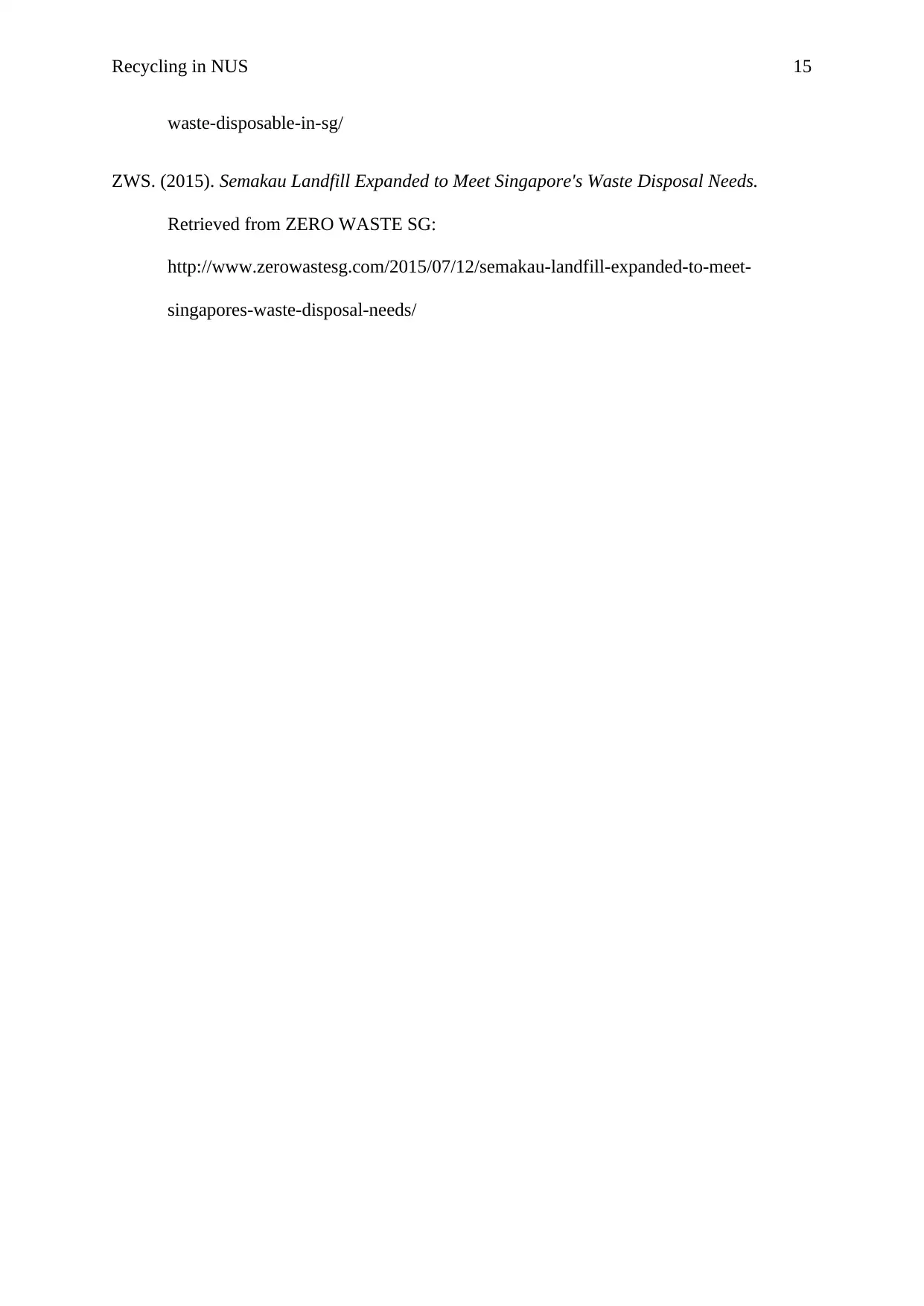
Recycling in NUS 15
waste-disposable-in-sg/
ZWS. (2015). Semakau Landfill Expanded to Meet Singapore's Waste Disposal Needs.
Retrieved from ZERO WASTE SG:
http://www.zerowastesg.com/2015/07/12/semakau-landfill-expanded-to-meet-
singapores-waste-disposal-needs/
waste-disposable-in-sg/
ZWS. (2015). Semakau Landfill Expanded to Meet Singapore's Waste Disposal Needs.
Retrieved from ZERO WASTE SG:
http://www.zerowastesg.com/2015/07/12/semakau-landfill-expanded-to-meet-
singapores-waste-disposal-needs/
1 out of 16
Related Documents
Your All-in-One AI-Powered Toolkit for Academic Success.
+13062052269
info@desklib.com
Available 24*7 on WhatsApp / Email
![[object Object]](/_next/static/media/star-bottom.7253800d.svg)
Unlock your academic potential
© 2024 | Zucol Services PVT LTD | All rights reserved.



